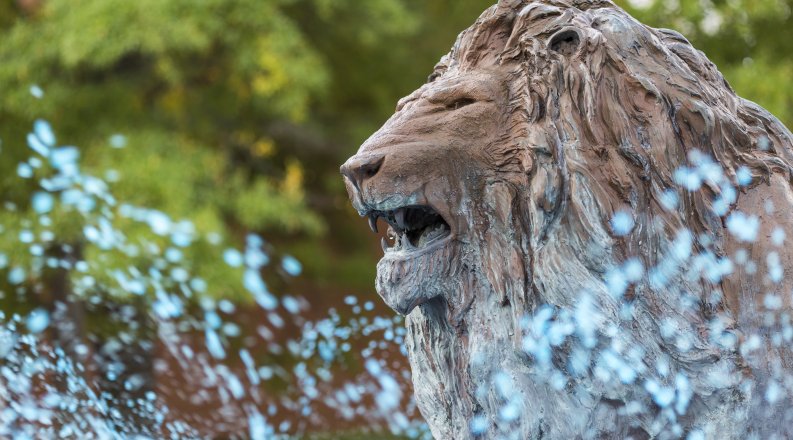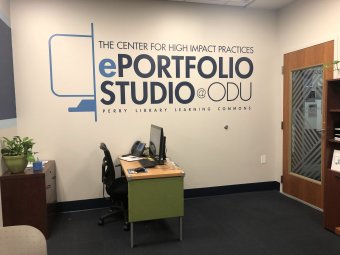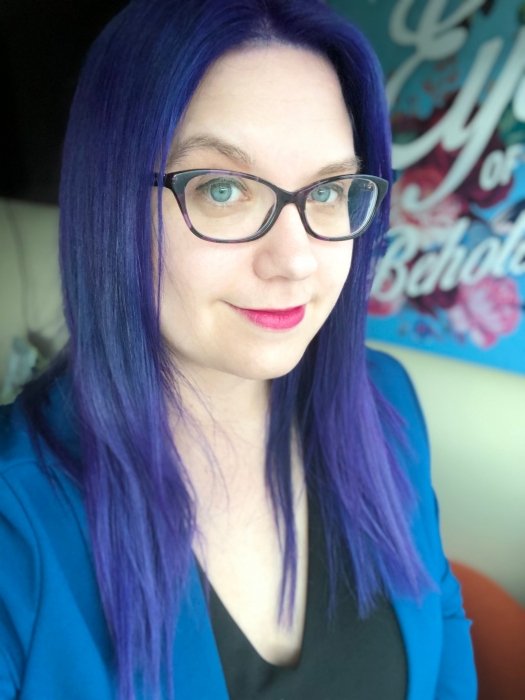The ePortfolio Studio in Perry Library Learning Commons
Megan Mize
By David Simpson
What if there was a tool that could help your students archive their coursework, think about their growth and retain what they've learned?
Plus, help them build their digital skills? And even get a job?
There is such a tool. You've surely heard of ePortfolios (ePs) - they've been around for a couple of decades - but maybe you're not using them in your classes.
In the past few years they've taken off at ODU. Thousands of students create them each semester at the direction of a faculty member or a program, said Megan Mize. She's the associate director for ePortfolios and digital initiatives in the Center for High Impact Practices (CHIP).
"EPortfolios tell you a lot about the learner," Mize said. "And you get to see evidence of them learning. It's really quite cool."
Here's how they work, according to the Center's ePortfolios site: To demonstrate learning or skills, students create websites where they can upload presentations, images, documents, reflections, blogs, audio and video. Students can then share items with whomever they choose - professors, advisors, potential employers.
There are two basic types of ePs:
- An archive of materials, saved over time, that documents the process of learning
- A showcase, carefully crafted after the fact, that displays learning, experiences or skills
An archive might include several versions of works in progress - say, a piece of music, a lab experiment or a term paper - as well as the final version.
A showcase, on the other hand, is mainly for a public audience. These "personal professional websites" give employers a vivid picture of what an applicant has studied and can do.
What's more, hiring managers are looking for candidates who are digitally literate. Mize mentioned a recent graduate - a former eP assistant in her office - who was interviewing for a job. The alumna's portfolio includes a video she edited of the turtles on ODU's campus.
"Her interviewers just went nuts over this video," Mize said, "because they don't know how to make a video, they don't know how to edit a video, they didn't know how she uploaded it to YouTube and they didn't know how she embedded it on her website."
It's not that they were so interested in turtles.
"They were most interested in that skill set, where she could communicate information for an online audience."
In normal times, Mize offers workshops and tutoring for faculty and students in the ePortfolio Studio, 1313 Perry Library Learning Commons. During COVID-19, support and training are being held virtually. About 120 ODU instructors have gone through the introductory three-day training in how to incorporate ePs into their classes, she said.
Faculty members have wielded the tool in a variety of ways.
Jesse Richman, an associate professor of political science, uses portfolios in POLS 400 - Congress. Throughout the semester each student plays the role of a member of the U.S. House or Senate, representing a specific state or district.
They write a series of documents as they learn their district, plan their legislative agenda and request committee assignments, he said. Then they draft bills and try to move them through the lawmaking process.
"As a summative project, students construct an ePortfolio, which is the 'website' of the member of Congress they have played," Richman said. "It pulls together most of their assignments, while also building website-construction skills."
Students cap this project with a reflection on what they've learned through the course, and how the way they played the simulation reflects that learning, he said.
Scott Sechrist used ePs in NMED 331 - Fundamental Concepts in Nuclear Medicine Technology. Before he retired after the spring semester, the associate professor would lead students through the physics and physical characteristics of about 20 radionuclides that are pertinent to medical imaging.
Meanwhile, each learner became an "expert" on one radionuclide by creating an eP about it, Sechrist said. The eP links were then shared with other students, so everyone benefited from the collected research.
He also asked them to include a historical summary of their radionuclide, a section in which they boiled their project down to a 5- to 10-line poem, and a short reflection on how the project heightened their learning.
"Distilling the information down into pertinent, meaningful, clearly communicated 'chunks' is a skill that will serve them throughout their time in the program and in the field of medical imaging," Sechrist said.
Although ePortfolios have mushroomed at ODU, Mize would like to see more faculty members embrace them.
Don't think of ePs as a fancy tech adoption, she said. Instead, think about the issues you and your students face that could be helped by reflection and synthesis.
"And moreover, think about how we are preparing students to communicate in the digital sphere in our own fields. I think the ePortfolio is a great springboard for that."
For more information, including sample portfolios, visit the ePortfolios website. Owing to the current health crisis, ePortfolio events have moved online. Looking for support? Contact Mize at eportfolio@odu.edu or mmize@odu.edu.





